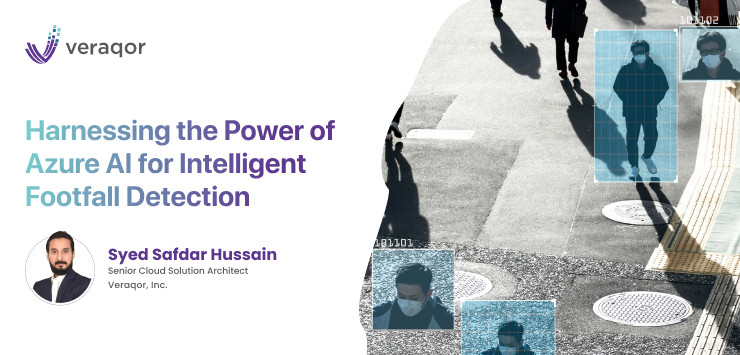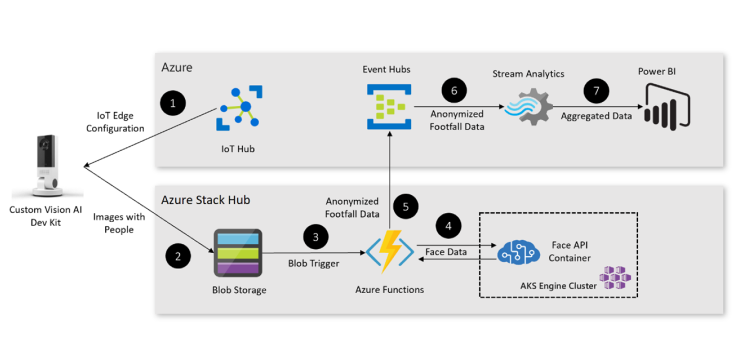Traffic and footfall analysis is critical to many modern-day businesses. It has become imperative to know what works best for buyers and consumers, and these insights into customer behavior are leading businesses to make better and more informed decisions.
That is why today’s businesses are constantly seeking insights into customer behavior. Brick-and-mortar stores, for example, can benefit tremendously from understanding foot traffic patterns. This knowledge can be used to optimize multiple fronts and enable better productivity standards and control.
In this blog post, we’ll briefly explore how to leverage Azure AI and Computer Vision services to implement a footfall detection system.
Implementation of an Intelligent Footfall Detection System using Azure AI
Microsoft Azure offers a robust suite of artificial intelligence and cognitive services that can empower businesses to create intelligent footfall detection solutions. This can solve multiple challenges faced by store owners, including unclear store layouts, messed up staffing schedules, and vague marketing campaigns.
But what does it take to build such a system? Azure’s Computer Vision capabilities.
Azure Computer Vision is a cognitive service that has a set of APIs that provide advanced image and video analysis capabilities. It leverages artificial intelligence and machine learning capabilities to perform multiple predefined actions.
It can detect objects, including people, in real-time video streams and set off alarms based on any visual threat of mismanagement and otherwise, which can be a great help.
This can enable business owners and enterprises to develop systems that automatically analyze video footage right from their cameras and know what’s happening. The system can identify and count individuals entering and exiting designated areas, providing valuable customer traffic insights.
Building a Footfall Detection System with Azure AI
The intelligent footfall detection system powered by Azure can be broadly divided into three stages:
1. Data Acquisition
Set up your video source, which can be a pre-recorded video or a live camera feed. Ensure the video format and resolution are compatible with Azure services.
2. System Design and Development
Design the system architecture to process the video stream. The system will extract frames, call the Azure Vision API to detect people in each frame and track their movements to determine entry and exit counts.
3. Footfall Analysis & Insight
Analyze and accurately track footfall and pedestrian movement in a designated area, distinguishing between entries and passersby. Count total entries/exits over time and visualize trends using tools like Power BI to make strategic decisions.
Hybrid & Real-Time Solution Architecture
To build an intelligent footfall detection system, whether hybrid or real-time solution architecture, including the process and components, here’s how it works.
How It Works
- The IoT Hub provides information and configuration details to the Custom Vision AI Dev Kit, which then runs and installs the IoT Edge Runtime and an ML model to perform the actions.
- During its operation, when the model detects a person, it then takes a picture, which is then uploaded to an Azure Stack Hub blob storage for further usage/analysis.
- Once uploaded, the blob service then intimates and triggers an Azure Function on Azure Stack Hub for further detailing.
- The trigger Azure Function then calls a container having the Face API, which fetches the demographic and emotional data from the image subsequently.
- This data is then anonymized and forwarded to an Azure Event Hubs cluster.
- Data from the Event Hubs cluster goes to Stream Analytics.
- Stream Analytics aggregates the data and sends it to Power BI, which uses a simple dashboard to show what Azure Stream Analytics does.
Components Used for Intelligent Footfall Detection System
- Custom Vision AI Dev Kit helps filter images in stores by using a special AI model that only looks at pictures of people. It stays safe and gets updates through IoT Hub.
- Azure Stack Hub expands Azure capabilities by enabling the deployment of applications in an on-premises environment and always providing Azure services within your datacenter.
- The App Service resource provider (RP) serves as a foundation for edge components, offering hosting and management functionalities for web apps, APIs, and Functions.
- The Azure Kubernetes Service (AKS) engine is deployed within Azure Stack Hub, running the Face API container and offering scalability and resilience for operations.
- Azure Cognitive Services RP offers Face API containers, enabling features such as demographic analysis, emotion recognition, and unique visitor detection.
The Benefits of Azure-Based Footfall Detection
Implementing a footfall detection system using Azure AI and Computer Vision services offers several advantages:
- Enhanced Customer Insights: Gain valuable data on customer traffic patterns to optimize store operations and marketing strategies.
- Improved Staff Scheduling: Optimize staffing levels based on real-time foot traffic data, ensuring adequate personnel during peak hours.
- Data-Driven Decision Making: Make data-backed decisions to improve customer experience, store layout, and overall business efficiency.
Conclusion
Utilizing Azure AI and Computer Vision services enables the creation of an intelligent footfall detection system, offering crucial customer traffic insights. Leveraging this data analytics empowers informed decision-making, leading to improved customer experiences, streamlined store operations, and a distinct competitive advantage.
Talk to our experts for more information.

Syed Safdar Hussain
Syed Safdar Hussain is a seasoned cloud professional with over 14 years of expertise crafting cutting-edge digital solutions for global enterprises. His core competencies span enterprise-scale application development, cloud enablement, modernization, integration frameworks, and digital transformation, with a strong emphasis on security and compliance.

Syed Safdar Hussain
Syed Safdar Hussain is a seasoned cloud professional with over 14 years of expertise crafting cutting-edge digital solutions for global enterprises. His core competencies span enterprise-scale application development, cloud enablement, modernization, integration frameworks, and digital transformation, with a strong emphasis on security and compliance.




